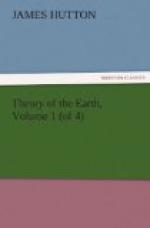Whatever conclusions, therefore, by means of this science, shall be attained, in just reasoning from natural appearances, this must be held as evidence, where more immediate proof cannot be obtained; and, in a physical subject, where things actual are concerned, and not the imaginations of the human mind, this proof will be considered as amounting to a demonstration.
SECTION II.
An Investigation of the Natural Operations employed in consolidating the Strata of the Globe.
We are now about to investigate those mineral operations of the globe by which the qualities of hardness and solidity, consequently of strength and durability, are procured to great bodies of this earth.
That those qualities are not original to such bodies, but actually superinduced in the natural operations of the earth, will appear from the examination of some of the hardest and most solid of those mineral bodies. In such masses, (for example of flint and agate,) we find included shells and coralline bodies. Consequently, there must be a natural operation in the globe for consolidating and hardening its soft and loose materials. It is concerning the nature of this consolidating operation that we are now to inquire.
There are just two ways in which porous or spongy bodies can be consolidated, and by which substances may be formed into masses of a natural shape and regular structure; the one of these is simple congelation from a fluid state, by means of cold; the other is accretion; and this includes a separatory operation, as well as that by which the solid body is to be produced. But in whichever of these ways solidity shall be procured, it must be brought about by first inducing fluidity, either immediately by the action of heat, or mediately with the assistance of a solvent, that is, by the operation of solution. Therefore, fire and water may be considered as the general agents in this operation, which we would explore.
Heat has been already mentioned as a general power, and as acting in all the different parts of the globe; I would now wish more particularly to call the attention of the reader to subterraneous fire, or heat, as a powerful agent in the mineral regions, and as a cause necessarily belonging to the internal constitution of this earth.
It is not our purpose at present to inquire into the particular nature of this power of subterraneous heat, or to trace the proper connection and analogy of the internal fire with that which is so necessary to our life, and which acts so great a part upon the surface of the earth, this being reserved for the last part. Our intention in here mentioning it, is only to dispose the mind to look for active powers or efficient causes, in that part of the earth which has been commonly considered as passive and inert, but which will be found extremely active, and the source of mighty revolutions in the fate of land.




